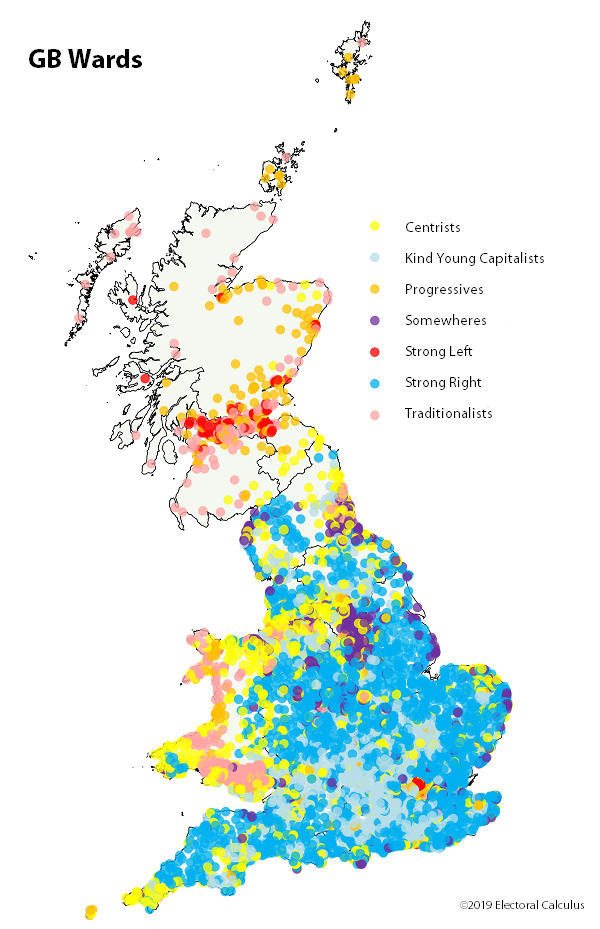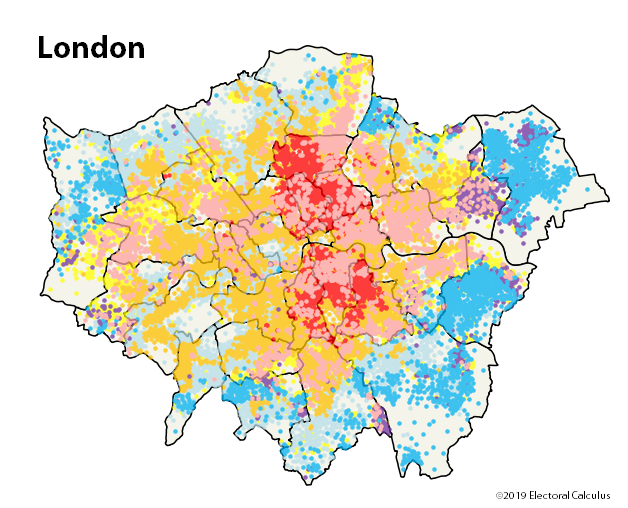Please note there is now an updated version of three-D politics for 2021.
Political views used to be something that you inherited from your parents. Gilbert and Sullivan put the thought into song in Iolanthe, their political satire of 1882,
That every boy and every gal
That's born into the world alive
Is either a little Liberal
or else a little Conservative!
And that truth held for over a century, albeit with Labour substituting for the Liberals. Political affiliation was tribal, with Conservative and Labour identification driven by family, class and income. In the post-war period, the key political debates centred around economic issues with people taking positions either on the left or the right, but always defining themselves by their position on that single economic spectrum.
But things are different now. People's political views are less driven by their family background. And there is now more to life than economics. People have views on nationalism/globalism, society, lifestyle, defence and security, the environment, consumer issues and many more. And these views can often cut across party lines. Brexit is a striking example where many Conservative and Labour remainers are uncomfortable with their party leadership's position.
To capture these new politics, we need to beyond the simple left-right axis. It's not wrong, but it's not enough. We need more. There are two other major axes that should be included in our political analysis: one for nationalism/globalism, and one for social attitudes ranging from liberal to conservative.
The three axes and their two sides of each one are shown in this table:
| Axis | Left side | Right side |
|---|---|---|
| Economic | Left-wing Higher taxes and spending, government regulation of business, nationalisation | Right-wing Lower taxes and spending, light regulation, private industry, competition and free markets |
| National | Globalist Pro-EU, internationalist, co-operate and share sovereignty with other countries, put global interest above national interest | Nationalist EU-sceptic, put Britain first, have Britain sovereign, controls on immigration, laws made in Britain not internationally |
| Social | Socially Liberal Permissive, allow people to do their own things, accepting of minority rights, multiculturalism | Socially Conservative Traditional, value authority, supportive of dominant culture and moral majority |
Everyone in the country will have a position on each of these three axes. Their position might be at either of the extreme ends, or closer to the middle. And people can have different positions on each axis. Someone can be both left-wing economically and socially conservative, just as another person can be socially liberal and economically right-wing.
But how many people fall into each category and into each combination of categories? To find out we need quite a big poll which asks many questions. Luckily, there are some polls which have done all this. The British Election Study (BES) is a long-running series of polls run by academics from the Universities of Manchester, Nottingham and Oxford.
To get a good set of questions, we have combined three waves of BES polls (waves 7, 10 and 13) which were conducted between April 2016 and June 2017. In total, around 13,600 people took part in all of these three waves. As well as demographic and political information, respondents were asked over fifty relevant questions about their political attitudes. Some of the questions were economic, some national, and some social. By looking at a respondent's average answer to, say, economic questions, we can calculate the economic "score" of that respondent. This can be repeated for the other two axes.
The result of this calculation is to have a three-dimensional score for each respondent giving their position on each axis. The scores are normalised to lie between −100 (extreme left) and +100 (extreme right), with the national average at the zero point (0).
To make sense of all this data, we have to group similar people together. One way of doing this is called "clustering" or cluster analysis, which divides the population into tribes (or clusters). In each tribe, its members have fairly similar political views.
Electoral Calculus prepared three-dimensional scores for each BES respondent, and ran clustering analysis on the results. This produced seven political tribes of the British electorate. They are:
| Tribe | Economic | National | Social |
|---|---|---|---|
| Strong Left | Very left-wing | Very globalist | Very liberal |
| Traditionalists | Fairly left-wing | Moderate | Moderate |
| Progressives | Mildly left-wing | Quite globalist | Liberal |
| Centrists | Average | Average | Average |
| Somewheres | Slightly left-wing | Strongly nationalist | Strongly conservative |
| Kind Young Capitalists | Quite right-wing | Mildly globalist | Mildly liberal |
| Strong Right | Very right-wing | Nationalist | Conservative |
Find out more about the tribes by clicking on any of the buttons below.
| Strong Left | Traditionalists | Progressives | Centrists | Somewheres | Kind Young Capitalists | Strong Right | |
|---|---|---|---|---|---|---|---|
| Description | Left Intelligentsia | Traditional Labour working class | Blairites | Mr and Mrs Average | Conservative working class | Modern yuppies | Conservative heartland |
| Size | 4%, smallest | 10% | 11% | 24%, joint largest | 12% | 24%, joint largest | 15% |
| Voting | Very Labour, also Lib Dem and Nat | Fairly Labour | Strong Labour, but also Lib Dems, Greens and Nats | Can support any, but Labour slightly preferred | Conservative-voting, with some UKIP | Can support either, prefer Conservatives | Heavily Conservative |
| Three D Score Position | Very left wing, very globalist, very socially liberal | Pretty left-wing, moderate in nationalist/social issues | Mildly left-wing, but quite globalist and socially liberal | Average opinions on the economy, nationalism, and social issues | Slightly left-wing economically, but strongly nationalist and socially conservative | Quite right-wing economically, but mildly globalist and socially liberal | Very right-wing economically, but also nationalist and socially conservative |
| Social Class | Middle class, ABC1 | Working class, DE | Middle class, ABC1 | Average | Working class, C2DE | Average | Average |
| Age/Gender | Male, 18-34 | Male, 45-64 | 18-34 | Slightly younger than average | Male, 55+ | Female, 18-34 | Male, 55+ |
| Education | Well-educated | Little education | Well-educated | Not degree-level | Little or basic | Well-educated | Basic |
| Religion | Atheist | Christian | Atheist | Average | Christian | Some Muslims | Christian |
| Tenure | Private rented | Council housing | Private rented | Some council housing | Council housing | Private rented | Owner occupier |
| Personal Status | More likely not working; unmarried | More likely not working or unemployed; divorced | Likely fully employed or student; unmarried | Average | Retired or unemployed; divorced or widowed | Some non-workers, unemployed; unmarried | Retirees; married or widowed |
| Area | Often found in London, Scotland and Wales | Provincial (not London) | Often found in London or Scotland | Everywhere | Often found in the North East, not London | Everywhere | Everywhere, many in East Anglia |
| Media | Guardian | Daily Mirror | Guardian or Times | Average | Sun | Few newspapers, except Times | Daily Mail, Daily Telegraph |
| EU Ref vote | Very strong Remain | Fairly evenly split | Very strong Remain | Slightly voted Leave | Very strong Leave | Likely Remain | Very heavily Leave |
| GE 2015 vote | Might have voted Green, now Labour | Solid Labour | Maybe voted Lib Dem or Green | Balanced Con/Lab | Quite UKIP, and Con/Lab | Were more Conservative | Some UKIP, very Con |
| Spiritual Leader | Jeremy Corbyn, Nicola Sturgeon | Frank Field | Tony Blair | Mr and Mrs Average | Nigel Farage | Ruth Davidson | Jacob Rees-Mogg |
Let's look at the tribes in 3D political space. The 3D chart below shows each tribe as a sphere. The volume of each sphere is proportional to the size of the tribe in the population. The position of the centre of the sphere shows the Economic, National and Social scores of the tribe's centre. The economic axis is the red one, running from the left-wing ('LEFT') to right-wing 'RIGHT'. The national axis is blue, running from globalist ('GLOBAL') to nationalist ('NATIONAL'). The social axis is GREEN running from socially liberal ('LIBERAL') to socially conservative ('CON').
You can view the 3D chart from any angle by left-clicking anywhere on the chart and dragging your mouse. The original rotational view can be resumed by double-clicking anywhere on the chart.
Please press the 'Show Diagonal' button to display the diagonal line from goes from the left/global/liberal corner across to the right/national/conservative corner. Traditional political theory suggests that people and tribes should be found on this (magenta) diagonal line. This line represents the standard one-dimensional political spectrum from 'full left' to 'full right'. It is often simplistically assumed that people can only have views which are somewhere on this line. But reality is more complicated. Although some tribes lie on or near that line (Strong Left, Progressives, Centrists and Strong Right), about half of the population belongs to tribes which are not near the diagonal line.
For example, the Traditionalists are more left-wing, more nationalist and more socially conservative than their closest point on the diagonal line. Although further to the right, the Somewheres are also more left-wing, nationalist and conservative than the one-dimensional diagonal would suggest. In the other direction, the Kind Young Capitalists are more right-wing, more globalist and more socially liberal than their nearest point on the one-dimensional spectrum. The Progressives are quite close to the diagonal but are a little more right-wing and more globalist than the line implies.
We can also see geographically where people from each tribe live. We can use modern regression tools to estimate the proportion of people in any local authority ward who would be in each tribe. This is done firstly by "machine learning" to discover the typical political and demographic profile of people in each tribe, and then applying those rules to public census and electoral data at the ward level.
Doing this lets us identify the dominant tribe in each ward. This is shown on the map below of all wards in Great Britain (England, Scotland and Wales). There are 8,734 wards, using the ward boundaries of 2015.

As usual, rural areas appear over-represented on the map, so the apparent dominance of the "Strong Right" tribe is illusory. More detail can be seen on regional maps which are available below.
At a regional level, we can go into more detail and see tribes for each "output area". An output area is a very small geographical area, defined by the national 2011 census, which has about 200 people in it. They are normally made up of a couple of streets, so provide a very fine-grained geographical view.
The interactive feature below allows you to choose which area to view by clicking on the appropriate button.

You can also take a short survey to find out which tribe you belong to.
Read the updated version for 2021.
Return to the home page.